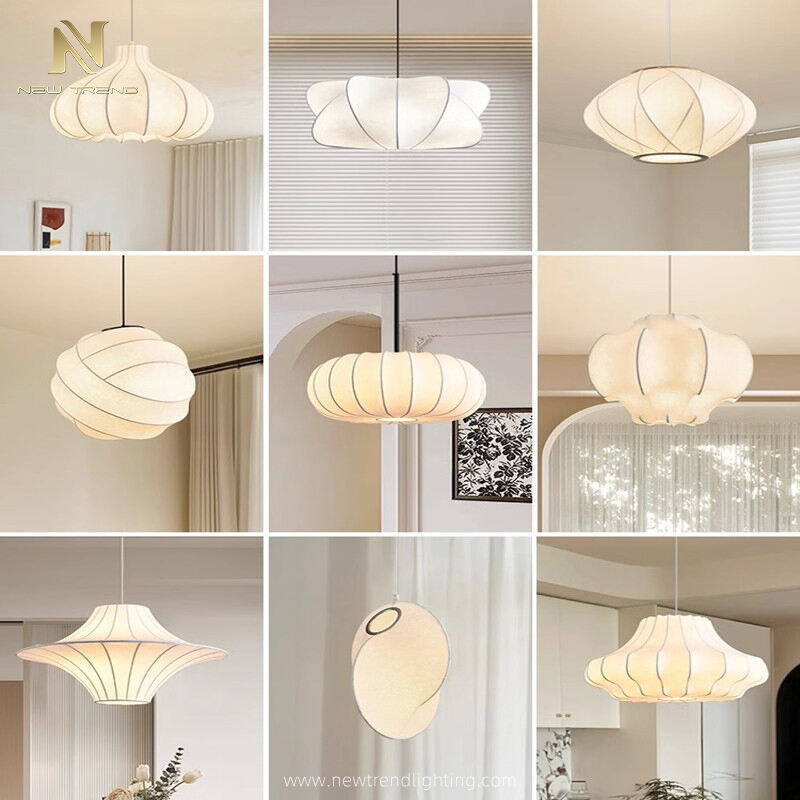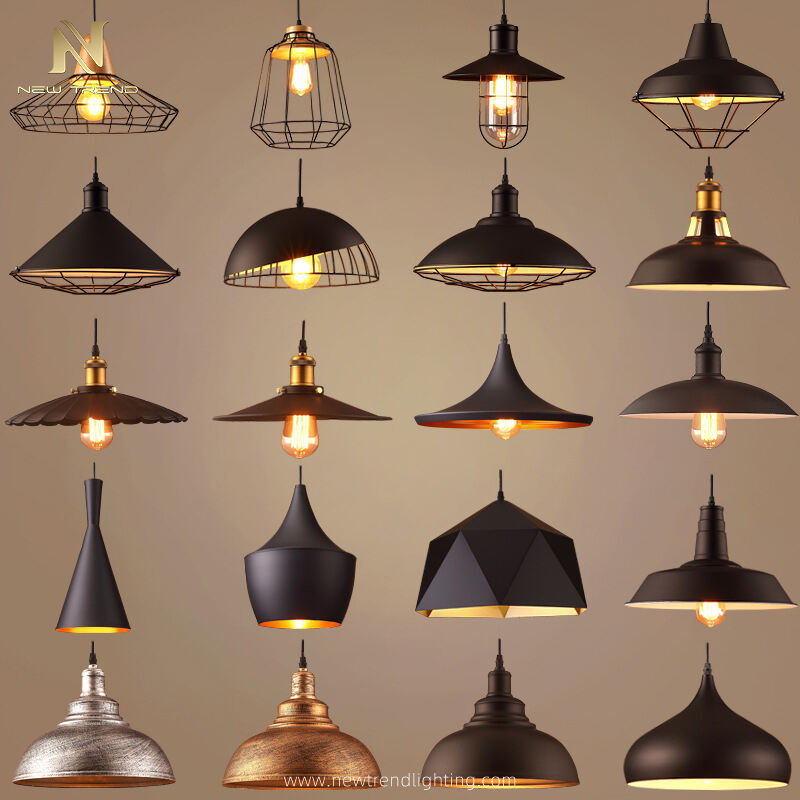Oshxona orolidagi osma chiroqlarni qanday tanlash kerak
Oshxonaning funktsionalligi va muhitini belgilashda yoritish dizayni muhim rol o'ynaydi. Turli xil jihozlarning orasida osma chiroqlar eng ko'p tomonlama va uslubli variantlardan biridir, ayniqsa oshxona orolidagi stollarning ustida foydalanilganda. Oshxona orosi bir nechta maqsadlarga xizmat qiladi: bu ovqat tayyorlash joyi, ovqatlanish joyi, ijtimoiy to'plangan joy yoki hatto ish sirti bo'lishi mumkin. Shu ko'p maqsadlilik tufayli uning ustidagi yoritish amaliy yoritish va estetik jo'shqinlik o'rtasida to'g'ri muvozanatni saqlashi kerak. To'g'ri tulpar lampasi sozlamada kerakli o'lcham, balandlik, dizayn, material hamda oshxonaning umumiy uslubini hisobga olish orqali diqqat bilan tanlash talab qilinadi.
A tulpar lampasi faqatgina yoritish manbai emas. Bu shuningdek, oshxona dizaynini birlashtiruvchi element hisoblanadi. Shu ehtimollikka e'tibor qaratish kerak: to'g'ri tanlangan podvesnoy lampa oshxonaga chuqurlik, matnura va dramatizm qo'shadi. Aks holda, noto'g'ri tanlov noaniqlik, yetarli bo'lmagan yoritish yoki vizual shovqin hosil qiladi. Tanlash jarayonini qanday amalga oshirishni bilish podvesnoy lampochka oshxonada ham funksional, ham bezak vazifasini bajarishini kafolatlaydi.
Oshxona dizaynida podvesnoy lampochkalar roli
Oshxona orolidagi orolidagi shlyuz ko'pincha butun xonaning asosiy nuqtasi bo'lib xizmat qiladi, shu sababli uning ustiga osilgan osma chiroq ham ko'zga ko'rinadigan markaziy elementga aylanadi. Yashirin yoritishdan farqli o'laroq, osma yoritish ko'rinadigan, ifodali va sozlanadigan bo'ladi. Osma chiroqning shakli, rangi va to'liq ishlanishidan tashqari, u oshxonaning xarakterini yaxshilovchi belgili dizayn elementi bo'lib xizmat qiladi. Zamonaviy oshxonada ingichka, minimalistik osma chiroqlar to'g'ri chiziqlarni yaratadi, qishloq uslubidagi yoki qishloqqa xos oshxonada esa katta va matallasi ko'proq bo'lgan osma chiroqlar issiqlik va charmdan foydalanadi.
Funktsionallik ham teng darajada muhim. Oshxona orolidagi turli vazifalarni bajarish uchun yetarli yoritish kerak. Sabzavotlarni kesish, retseptlarni o'qish yoki noformal ovqatlanish hammasi to'g'ri yoritish darajasiga bog'liq. Osma chiroqlar orol ustiga to'g'ridan-to'g'ri hamda yetarli yoritishni ta'minlaydi, shunda ish sirti yaxshi yoritiladi. Shu bilan birga, ular tashabul bilan ishlaydigan yoritishni yaratishda, shkaf ostidagi chiroqlar va shiftga o'rnatilgan chiroqlar bilan birga ishlab, turli vazifalarga moslanuvchan muhit yaratadi.
To'g'ri o'lcham va masshtabni aniqlash
Oshxona oroli uchun osma chiroq tanlashning dastlabki qadami to'g'ri o'lchamni aniqlashdir. Judayam kichik chiroq nohamkor ko'rinishi mumkin va yetarli yoritishni ta'minlamaydi, judayam katta bo'lsa, u esa fazoviy jihatdan qamrab oladi va noaniq, muvozanatsiz ko'rinish yaratadi. Chiroq o'lchami orolning o'lchamlariga hamda umumiy oshxonaga mos kelishi kerak.
Ko'rsatma sifatida, orolidagi lampochkalar sonini hisobga olishda orolning kengligini o'lchash va uni vizual ravishda bo'lish foydalidir. Katta orol uchun ikkita yoki uchta lampochka mos keladi, kichik orollar uchun esa bitta katta lampochka samarali bo'lishi mumkin. Har bir lampochka etarli yorug'lik berishi kerak, shu bilan birga atrofida yetarli joy qolishi kerakki, shunday qilib lampochka noqulay ko'rinishdan saqlansin. Lampochkaning o'lchami shuningdek, mutoqning boshqa elementlari, jumladan, mebel, maishiy asboblar va ovqatlanish stollari bilan mos kelishi kerak, shunda u alohida turganidek emas, balki umumiy dizaynning bir qismi ekanligini his qilinsin.
O'rnatish va osish balandligi
Shirafiga osiladigan lampochkalarni bezashda o'lcham qanchalik muhim bo'lsa, joylashuv ham shunchalik muhim. Shirafiga osiladigan lampochkalar orasidagi masofa shirafiga teng ravishda taqsimlanishi kerak, shunda yorug'lik ham tekis bo'ladi. Bir nechta lampochkalar ishlatilganda, ular orasidagi masofa shunday hisoblanishi kerakki, yorug'lik tekis tarqalsin. Agar lampochkalar juda yaqin bo'lsa, bitta joy juda yorug' bo'ladi, agar ular juda uzoqda bo'lsa, shirafiga qorong'i zonalar hosil bo'ladi.
Orolar ustiga osilgan lampalar balandligi ham muhim tafsilotdir. Juda baland osilgan lampalar yetarli ish yoritishni ta'minlamaydi, past osilganlar esa ko'rinishni cheklaydi va charchoq hosil qiladi. Umumiy qoida sifatida, osma lampalar tagini ish stolining yuqori qismidan 30 dan 36 dyuymgacha balandlikda osish tavsiya etiladi. Bu yoritish samaradorligini saqlab turadi va ko'riylik ochiq bo'lishini ta'minlaydi. Shifoxona balandligi, lampalar o'lchami va xonalarning ma'lum ehtiyojlari asosida sozlamalarni o'zgartirish mumkin. Juda baland shifoxonalarga ega oshxonalar uchun osma lampalarni pastga osish yoki klaster sifatida guruhlash orqali dizaynni ko'z darajasiga yaqinroq qilish va intimaqlik yaratish mumkin.

Fazoga Mos Stilni Tanlash
Shirafta osilma chiroq uslubi moshinaning umumiy estetikasi bilan mos kelishi kerak. Yaltiroq mebelli va minimal furnitura bilan jihozlangan zamonaviy oshxonada toza chiziqlar, betaraf ranglar va metall qoplamali osilma chiroqlar yaxshi natija beradi. Aksincha, an'anaviy oshxonalar me'morchiligi bilan mos keladigan bezakli tafsilotlar, shishali lampa kapaklari yoki antik qoplamalarga ega chiroqlardan foydalanadi.
Sanoat uslubidagi oshxonalar uchun metall va betondan tayyorlangan osilma chiroqlar haqiqiylik va matematik mat texnikasini qo'shadi. Ferma yoki qishloq oshxonalarida esa yog'och bezaklar, to'qilgan matallar yoki eskirgan uslubdagi qoplamalar bilan katta chiroqlar issiqlik va tanishlik hissini keltiradi. Skandinaviya oshxonalarida odatda tabiiy qoplamalar va sodda siluetli minimalistik chiroqlar afzal ko'riladi, xilma-xil oshxonalar esa shaxsiylik va o'yinchoqlik qo'shadigan qiziqarli ranglar va nooddatiy shakllarga imkon beradi.
Shirincha lampochka oshxona uslubiga mos kelishi hamda qo'shni joylar bilan ham muvozanatli bo'lishi kerak. Ko'plab zamonaviy uylarda oshxona ovqat xona va yashash xonalari bilan uzluksiz oqimda bo'ladi. Bunday hollarda, shirincha yoritish atrof-muhitdagi asboblar bilan muvofiqlashtirilishi kerak bo'lib, butunlikdagi ko'rinish tarixini yaratadi.
Materiallar, Ranglar va Yakunlovchi qoplamalar
Shirincha lampochkaning materiali uning bardoshliligi va tashqi ko'rinishini ta'siqqlaydi. Metaldan yasalgan shirinchalar ko'p maqsadli va bardoshli bo'lib, sanoat va zamonaviy sozlashlarda qo'llaniladi. Shishali shirinchalar yorug'likni chiroyli tarqatadi va an'anaviy hamda zamonaviy oshxonalar uchun mos keladi, yengillik va zavq hissini beradi. Matodan yasalgan shirinchalar yumshoqlik hissini keltirib chiqaradi, lekin oshxonada pishirish paytida chiqadigan bug'ga qaramoqqa turinganligi sababli saqlash qiyin bo'lishi mumkin. Shto'p, daraxt yoki gil kabi tabiiy materiallar ilmiq va matonlik hissini keltirib, dizaynga chuqurligi qo'shadi.
Rang hamda tozalash uslubi oshxona atrof-muhitini ham belgilaydi. Yorug' rangli oshxonada qora yoki mat uslubdagi tozalash ahamiyatli kontrast yaratadi, shuningdek, latun va oltin ranglari shikastlik va iliq his yaratadi. Xromli va yashmatli pendants sovutuvchi yorug'likni aks ettiradi va zamonaviy asboblar bilan moslashadi. Shaffof yoki loyqa shishali lampa yumshoq yorug'lik beradi, rangli shisha esa o'yinchoq element qo'shadi. Tozalash uslubi xonadagi boshqa jihozlarni, masalan, shkaflar tutqichlari, chuvichlari yoki asboblar bezaklari bilan mos kelishi kerak, shu bilan dizaynda birlilik yaratiladi.
Funktsionallik va yorug'lik sifati
Shirin lampochkaning samaradorligi uning tashqi ko'rinishiga bog'liq bo'lmaydi, balki u beruvchi yorug'lik turi hamda uning vazifasiga ham bog'liq. Ba'zi lampochkalar pastga qarab ishlovchi yorug'lik berish uchun mo'ljallangan bo'lsa, boshqalari yarim shaffof abajurlar orqali atrofni yoritadi. Sozlanuvchan va yorug'lik darajasini o'zgartirish imkoniyati esa egallangan xonaning vazifasiga qarab yorug'likni boshqarish imkonini beradi. Masalan, oshpazlik qilish vaqtida yorug'lik ishlovchi yorug'lik muhim bo'lsa, ovqatlanish yoki mehmonlarni qabul qilish uchun yumshoq yorug'lik esa dam olish atmosferasini yaratadi.
Lampochka tanlovi ham muhim. LED lampalar energiya tejovchi va uzoq muddatli foydalanish imkonini beradi, shu sababli ular eng amaliy tanlov hisoblanadi. Lampochka rang temperaturasi ham mehrga ta'sir qiladi: issiq oq rang mehmonxona va jalb qiluvchi muhit yaratadi, sovuq oq rang esa ishga yo'naltirilgan faoliyatlar uchun qulayroq. To'g'ri lampochkani tanlash orqali shirin lampochka chiroyli ko'rinishi bilan birga samarali ham ishlaydi.
Xulosa
Oshxona orolidagi osma chiroqni tanlash funksional va uslubiy jihatdan muvozanatni talab qiladi. To'g'ri osma chiroq umumiy dizaynni yaxshilaydi, turli vazifalarni bajarish uchun yetarli yoritishni ta'minlaydi va xonani birlashtiruvchi ko'zga ko'ringan markaziy element bo'lib xizmat qiladi. O'lcham, joylashtirish, uslub, material, tozalash va yoritish sifati kabi omillarni hisobga olish orqali uy egasi oshxonani amaliy hamda estetik jihatdan yaxshilash uchun oqilona tanlov qilishlari mumkin. Osma chiroq soddagina element emas, balki oshxona orolini uyning asosiy qismiga aylantiruvchi asosiy elementdir.
Ko'p so'raladigan savollar
Oshxona orolidagi osma chiroqlardan qancha ishlatish kerak?
Chiroqlar soni orolning o'lchamiga bog'liq. Kichik orollar uchun ko'pincha bitta katta chiroq yetarli bo'ladi, katta orollar uchun esa odatda ikkita yoki uchta teng masofada osilgan chiroqlar ishlatiladi.
Orol ustiga osma chiroq osish uchun ideal balandlik qanday?
Umuman olganda, osma chiroqning pastki qismi ish stolining yuqori qismidan 30 dan 36 dyuymgacha bo'lishi kerak, bu esa shisha devori balandligi va chiroqning o'lchamiga qarab sozlanadi.
Shirshalar oshxona boshqa jihozlari bilan mos kelishi kerakmi?
Ular bir-biriga qarama-qarshi emas, balki bir-birini to'ldiruvchi bo'lishi kerak. Shkafcha qulflashlari, sovutgichlar va yaqin atrofdagi yoritish jihozlari bilan moslashish tuzilishning butunligini yaratadi.
Shirshalar osh tayyorlash vazifalarini bajarish uchun yetarli yorug'lik berishi mumkinmi?
Ha, ayniqsa yorqin lampochkalarga ega bo'lib, to'g'ri balandlikda o'rnatilganda. Xuddi shu narsa uchun sozlanuvchi variantlar ham mos keladi.
Oshxonalar uchun shirshalarning qaysi materiallari eng yaxshisi?
Metal va shishaning duradiligi va tozalash qulayligi tufayli ular keng qo'llaniladi. Tabiiy materiallar, masalan, ratan yoki daraxt issiqlik qo'shadi, lekin ularni ehtimol ko'proq e'tibor talab qiladi.
Shirshalar ochiq rejali oshxonalar uchun mosmi?
Aynan shunday. Ular oshxona orolidagi shifolini vizual ravishda belgilashda yordam beradi va ovqatlanish va yashash maydonlaridagi yoritish bilan moslashtirilib, bir xil natija beradi.
Shirshalar uchun qaysi lampochka turi tavsiya etiladi?
LED lampochkalar energiya tejovchi, uzoq muddatli xizmat ko'rsatish va turli rang haroratlarda mavjudligi sababli eng yaxshi tanlovdir.
Bir oshxonada turli shtativli lampalar uslublarini aralashtirish mumkinmi?
Ha, lekin ular bir xil yakka elementlarga ega bo'lishi kerak, masalan, yakka qoplamasi, o'lchami yoki rangi, ko'zga ko'rinadigan chalkashlikni oldini olish uchun.
To'g'ri shtativli lampani qanday tanlash kerak?
Shtativli lampa orolidagi ostanovka va oshxona hajmiga mos kelishi kerak. Katta ochiq oshxonalar uchun katta shtativli lampalar, qimmatbaho joylar uchun esa kichikroq dizaynlar mos keladi.
Shtativli lampalar mutaxassislarning o'rnatishini talab qiladimi?
Ba'zi uy egalari ularni o'zlarining o'rnatishsa ham, to'g'ri sim tashlash, xavfsiz maxfiylik va to'g'ri o'rnatish uchun mutaxassislarning o'rnatish tavsiya etiladi.
Mundarija
- Oshxona dizaynida podvesnoy lampochkalar roli
- To'g'ri o'lcham va masshtabni aniqlash
- O'rnatish va osish balandligi
- Fazoga Mos Stilni Tanlash
- Materiallar, Ranglar va Yakunlovchi qoplamalar
- Funktsionallik va yorug'lik sifati
- Xulosa
-
Ko'p so'raladigan savollar
- Oshxona orolidagi osma chiroqlardan qancha ishlatish kerak?
- Orol ustiga osma chiroq osish uchun ideal balandlik qanday?
- Shirshalar oshxona boshqa jihozlari bilan mos kelishi kerakmi?
- Shirshalar osh tayyorlash vazifalarini bajarish uchun yetarli yorug'lik berishi mumkinmi?
- Oshxonalar uchun shirshalarning qaysi materiallari eng yaxshisi?
- Shirshalar ochiq rejali oshxonalar uchun mosmi?
- Shirshalar uchun qaysi lampochka turi tavsiya etiladi?
- Bir oshxonada turli shtativli lampalar uslublarini aralashtirish mumkinmi?
- To'g'ri shtativli lampani qanday tanlash kerak?
- Shtativli lampalar mutaxassislarning o'rnatishini talab qiladimi?



